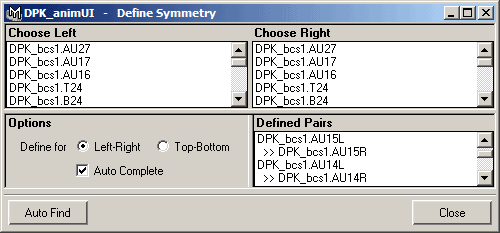The Define Symmetry window appears when you choose Define Symmetry… from the right-click popup menu of the section list. Here’s a screen shot of the window:

You use this window to manually specify which attributes belong together as left and right or as top and bottom. The script usually detects this based on the name of the attributes, so you’d rarely need to change the settings. When your names are not compatible, or the attributes of a pair are not on the same object, this window will allow you to correct this.
Advanced Info When you want your naming scheme to be recognized automatically, see the FAQ entry Is it possible to configure the automatic recognition of left-right attribute pairs?. |
Left-Right or Top-Bottom
Before starting to use the UI, make sure it is set to the correct axis. This can either be Left-Right or Top-Bottom and is specified in the Options part in the lower left corner. In left-right mode, you define and manage attribute pairs containing a left and a right attribute each. In top-bottom mode, you can specify the attribute pairs with top and bottom attributes.
The Two Upper Lists
The two lists in the upper part of the window contain the attributes that don’t have any symmetry defined (at least not in the current axis). Both lists contain the same attributes. They have the following items in their right-click menus:
Define Pair
To create a new attribute pair, select the left attribute in the left list and the right attribute in the right list and do a right-click Define Pair. This works the same for top-bottom pairs, the only difference being that the top attribute is chosen in the left list and the bottom in the right. After creating a new pair, it is listed in the Defined Pairs list and the attributes are removed from the two upper lists.
Warning The script doesn’t ensure the attribute pairs you create “make sense”. This means you could create, e.g., a top-bottom pair of two attributes that already are a left-right pair. |
Find Match
When you want to see which attribute the script would automatically find for a certain attribute, select it in one of the two lists and choose Find Match from its right-click menu. The found pair will be selected in the lists, but it is not created. In most cases, though, no attribute will be found since all pairs that the script finds will be created automatically. Only when you’ve removed a default pair can a match be found.
The Defined Pairs List
The Defined Pairs list in the lower right corner of the window lists all attribute pairs that have been created, either automatically or manually. The left (top) attribute of each pair is listed first, followed by the indented right (bottom). In the above image, AU15L is shown as left and AU15R as right attribute. This list has a right-click menu too:
Undefine Pair
This will remove a pair from the Defined Pairs list.
Reverse Pair
This will change the order of the two participating attributes, so that a left-right pair becomes a right-left pair.
Warning Please note that bilateral BCS weights are automatically recognized as left-right pairs and can neither be removed nor reversed. |
Auto Complete
The effect of this check box is a little complicated to explain (and not that important in most cases). I’ll try to show its use on a simple example.
Let’s say we have the attributes tL, tR, bL, and bR. We now create the left-right pairs tL-tR and bL-bR.
When we add the tL-bL top-bottom pair, we have three connections for four attributes. This means that the last connection—in this case the top-bottom pair tR-bR—is actually implied and can be created automatically.
When the check box is activated, this last pair will be created when a situation as described above is detected. Otherwise, you’re responsible for creating it.
Auto Find
This will remove all pairs of the current axis (left-right or top-bottom) and do the default search for matching attributes. The result is that the attribute pairs are reset to their original state they were in as you imported them.